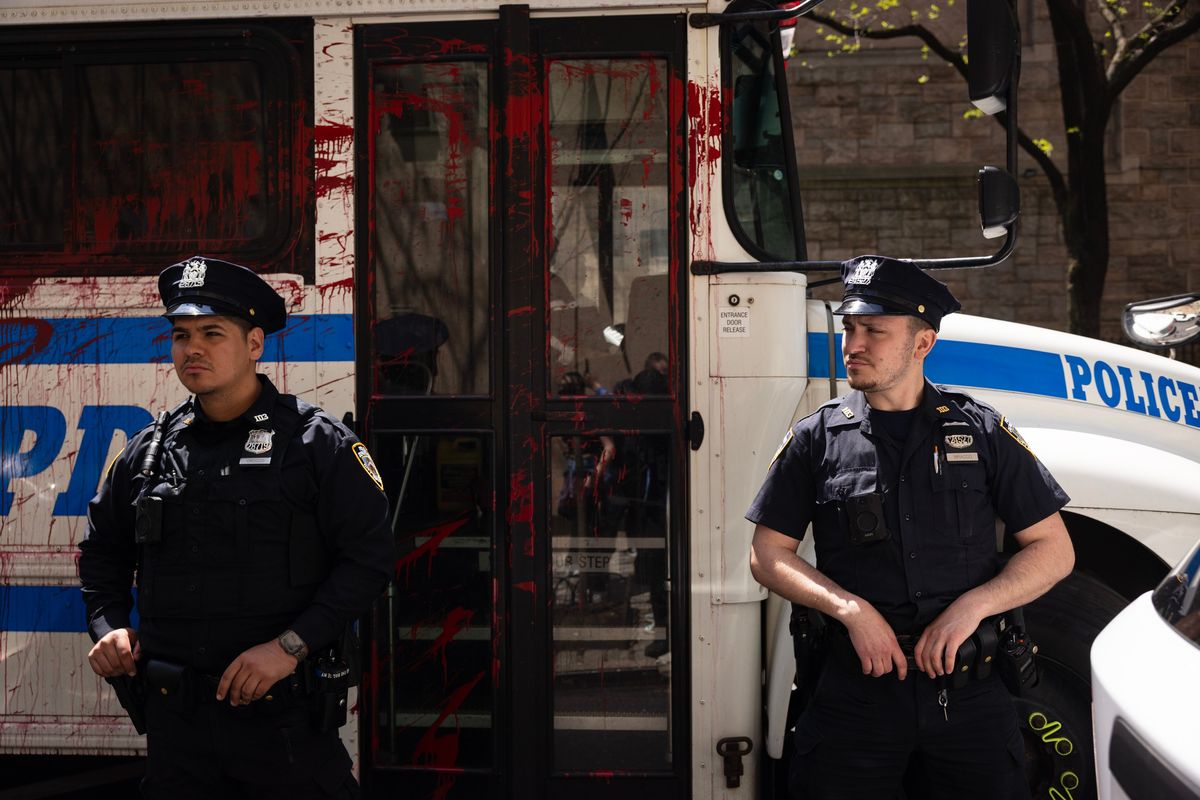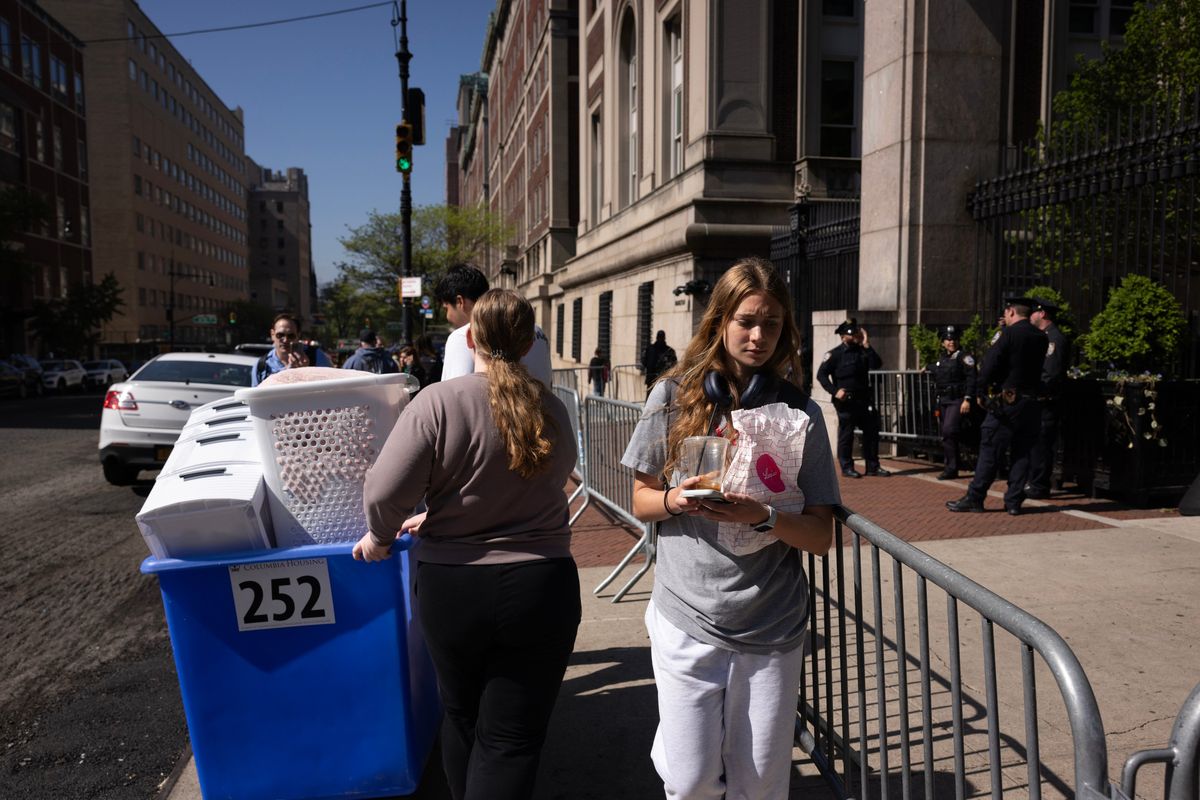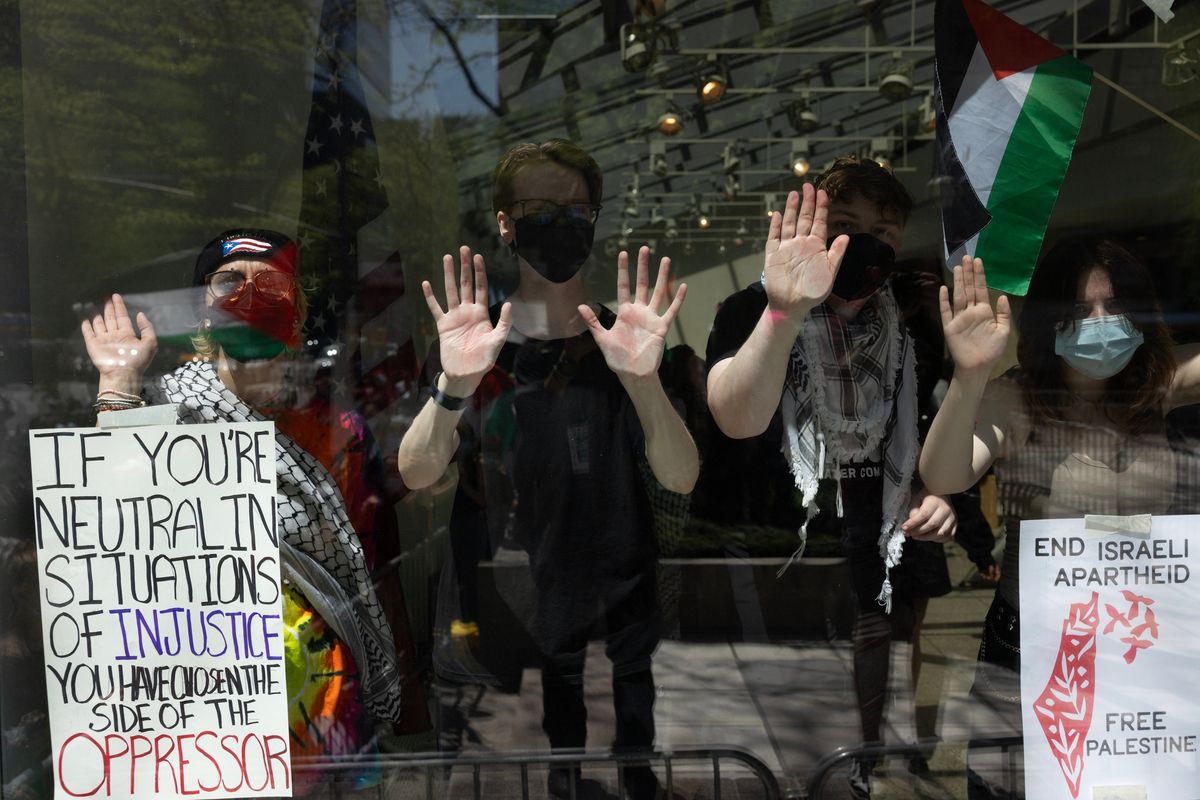After weeks of college protests, police responses ramp up
Pro-Palestinian students protest at Fordham University in New York on Wednesday. MUST CREDIT: Ed Ou for The Washington Post (Ed Ou/FTWP)
Colleges and universities reckoned Wednesday with the aftermath of major shows of police force across the country that cleared some protest encampments and emptied a Manhattan classroom building in a turning point following two weeks of contagious pro-Palestinian demonstrations.
Even after a fragile calm resettled over campuses that have seen the bulk of the chaos, footage of officers in riot gear extracting students from Columbia University’s Hamilton Hall – the most searing images from 24 hours of tense confrontations between law enforcement and protesters – sparked debates nationwide as Americans struggled to make sense of it all.
In a nation that prides itself on free expression – but where people report feeling less safe, even in places where crime is dropping – some administrators, criticized by all sides, have sought police help when negotiations with students, in their view, failed. With final exams and graduation approaching, pressure is rising for a swift return to order.
Over the last day, tensions have reached new heights. In Florida, among other states, police have dispersed campus rallies with tear gas. In Wisconsin, photos showed officers detaining a Madison professor with blood smeared on his forehead.
In California, masked men attacked a pro-Palestinian encampment on a Los Angeles campus – and students criticized police for not intervening sooner. Fifteen injuries, including a hospitalization, were reported after officers quelled the violence.
Columbia University has asked police to stay on campus for at least two weeks.
A few miles away, officers entered the lobby of a Fordham University building where protesters had set up an encampment and began making arrests late Wednesday afternoon. Demonstrators outside watched through the building’s floor-to-ceiling windows and chanted, “I don’t see no riot here! Why are you in riot gear?”
Eyes have also turned warily to campuses with ongoing building occupations, such as Portland State University, where students have barricaded themselves in a library and spray-painted “FREE GAZA” on the wall. Will riot police swarm that situation, too? Or will school leaders – like those at Brown University – find a way to stave off a massive escalation by agreeing to consider the protesters’ demands?
Since mid-April, student groups have pushed for institutions to cut ties with Israel and companies supporting its military campaign against Hamas that has killed about 34,000 people in Gaza, according to Palestinian health officials.
The movement has spread as divisions have deepened over U.S.-Israel policy since Hamas killed roughly 1,200 Israelis and took hundreds more hostage in a cross-border attack last October, prompting Israel to strike back, pulverizing much of the Gaza Strip.
Columbia said it had “no choice” but to call the police after demonstrators smashed windows and blocked doors Tuesday. New York Mayor Eric Adams (D) said that “outside agitators” had ianfluenced students to escalate, heightening the risk for everyone. He declined to provide further details.
Officers booked nearly 300 protesters at Columbia and the City College of New York that night, pushing the number of campus arrests over the last 14 days past 1,700, according to a Washington Post tally.
One student group involved in the demonstrations posted on social media that police had injured “multiple” students, who went to the hospital with “swollen faces from being kicked repeatedly.”
The New York Police Department did not respond to questions concerning that allegation to The Post. At a news conference earlier in the day, Deputy Commissioner Tarik Sheppard said the “overwhelming majority” of arrests involved “no injuries, no real scuffles with police.”
Striking visuals of officers flooding college campuses have triggered condemnation from labor leaders and left-leaning politicians. “When I was 11, I was a victim of police brutality just for being Black in America,” Rep. Jamaal Bowman (D-N.Y.) said on X. “Now I see that brutality being inflicted on peaceful students at Columbia and across the country.”
The White House’s reaction, on the other hand, seemed calibrated to address a bipartisan spectrum of concerns.
“We’re talking about a small group of students who are disrupting that ability for students to have that academic experience,” press secretary Karine Jean-Pierre said. Americans, she later added, have the right to protest peacefully.
“That is incredibly important,” she continued. “And we also have to condemn hate. … That is something that this president believes.”
On Capitol Hill, GOP leaders prepared Wednesday to advance a bill that they said would empower the federal government to curb anti-Israel protests on campuses by codifying a definition of antisemitism that includes certain criticisms of the Jewish state. House Majority Whip Tom Emmer (R-Minn.) had blasted what he saw as lenience on “pro-terrorist anti-Semites.” The legislation passed the House by a 320-91 vote, with a majority of Democrats joining Republicans.
Several Republican lawmakers have urged President Biden to call on the National Guard to dismantle encampments.
Former president Donald Trump, the presumptive Republican nominee, praised Columbia’s police response at a speech in Wisconsin.
“To every college president, I say: remove the encampments immediately,” Trump said, “vanquish the radicals and take back our campuses for all of the normal students who want a safe place from which to learn.”
Columbia, meanwhile, has opted to maintain a police presence on campus – an unusual move that surprised Edward Davis, a former commissioner of the Boston Police Department who now runs a security consultancy.
“It’s an indication that this is not a problem that’s going to go away quickly,” he said.
In recent days, Davis has been in touch with college presidents and police chiefs grappling with what they describe as an unwanted spotlight. Use of force in the future, he predicted, will depend on how well demonstrators respond to orders to disperse.
The NYPD response, he thought, was “measured,” even though observers were quick to blast it as going too far or not far enough. The university gave protesters ample time to leave, he said.
“No one is happy that they’ve been thrust into this situation,” he said. “It’s a very difficult time for everybody.”
After police arrested 10 demonstrators at the University of South Florida on Wednesday, the Hillsborough County sheriff released aerial video of the confrontation showing white clouds of tear gas filling the air.
“This is Florida, a law and order state,” Sheriff Chad Chronister said in the accompanying news release. “Every student, regardless of color, creed or religion, should be able to feel safe and learn in a secure environment.”
Protesters, his office added, had ignored “several” commands to disperse.
In Wisconsin, four police officers and three sheriff’s deputies were injured while trying to shut down illegal camping, according to a spokesperson from the University of Wisconsin at Madison.
Authorities arrested nearly three dozen protesters. At least two UW-Madison professors who were detained described injuries on social media or in interviews from the scene. One was Samer Alatout, a sociology professor who described himself to Milwaukee TV station TMJ4 as being of Palestinian descent and an adviser to the campus Student Justice for Palestine.
He and other faculty were attending to protect students’ right to protest without intimidation or threats of violence, he said.
His goal: “Block students from any violence by police,” Alatout said.
Another dramatic tangle erupted overnight at the University of California at Los Angeles, where masked counterprotesters tried to tear down makeshift barricades surrounding an encampment and aimed fireworks at where students were camping.
The police responded nearly two hours later – a delay that California Gov. Gavin Newsom (D) blasted as “unacceptable.”
Some of the pro-Palestinian activists tried to defend themselves with lumber and pepper spray. Fights broke out.
Ilan Berdy, a UCLA mechanical engineering student who watched the protests unfold on TV last night, said in a phone interview, “I’m Jewish. I’m Zionist. And I’m proud of both things. I’m not proud of what happened last night.”
UCLA hasn’t done enough to respond to the protesters who have taken control of the school in a “mob-like fashion,” he said, adding that they stationed themselves in walkways and prevented students from entering certain areas of campus for the last week.
“It’s been discriminatory,” he said.
Over at Columbia, students marveled Wednesday at how such a hectic scene – rows and rows of riot cops, protesters hauled off with zip-tied wrists – had cooled into a quiet morning.
Cameron Jones, a 19-year-old sophomore, walked up to the campus gates and peered at what remained of the pro-Palestinian encampment. Police, he noticed, had removed all the tents, leaving no trace but crushed grass.
“It was definitely very eerie,” he said. “This sense of fear was just hanging still in the air.”
Mohammad Hemeida, a 20-year-old junior, scanned a social media forum where users can up-vote anonymous posts. One slamming Columbia’s president was extra popular.
“SHAME ON YOU,” someone wrote alongside a picture of Minouche Shafik, according to a screenshot obtained by The Post.
Hemeida agreed with that message. And he disagreed with the assessment of Adams, the New York mayor, that Hamilton Hall had been full of “outside agitators.” He personally knew people who’d infiltrated the building and wound up arrested.
He wanted to bring them food when they got out.
“The community feels broken,” he said. “There is no longer a university here. It’s an administration with an endowment and the NYPD.”
Other students felt cautiously better.
Zachary Singerman, 19, had just ordered a scoop of Oreo ice cream to celebrate his birthday when he noticed the police officers putting on their riot gear Tuesday evening.
As a Jewish student, he said, he hadn’t felt safe the last couple of weeks. The anti-Israel sentiments worried him. Would protesters see him wearing a kippah and link him to the Jewish state?
“I have had nightmares about what is going on on campus,” said Singerman, who carries pepper spray.
The sight of the officers, he said, eased his mind.
- – -
Richard Morgan and Kyle Melnick in New York, Abigail Hauslohner Washington and Kim Bellware in Chicago contributed to this report.


